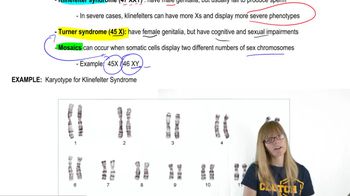Table of contents
- 1. Introduction to Genetics51m
- 2. Mendel's Laws of Inheritance3h 37m
- 3. Extensions to Mendelian Inheritance2h 41m
- 4. Genetic Mapping and Linkage2h 28m
- 5. Genetics of Bacteria and Viruses1h 21m
- 6. Chromosomal Variation1h 48m
- 7. DNA and Chromosome Structure56m
- 8. DNA Replication1h 10m
- 9. Mitosis and Meiosis1h 34m
- 10. Transcription1h 0m
- 11. Translation58m
- 12. Gene Regulation in Prokaryotes1h 19m
- 13. Gene Regulation in Eukaryotes44m
- 14. Genetic Control of Development44m
- 15. Genomes and Genomics1h 50m
- 16. Transposable Elements47m
- 17. Mutation, Repair, and Recombination1h 6m
- 18. Molecular Genetic Tools19m
- 19. Cancer Genetics29m
- 20. Quantitative Genetics1h 26m
- 21. Population Genetics50m
- 22. Evolutionary Genetics29m
3. Extensions to Mendelian Inheritance
Sex Chromosome
Problem 2
Textbook Question
Write a short essay that discusses sex chromosomes as they contrast with autosomes.
 Verified step by step guidance
Verified step by step guidance1
Step 1: Define sex chromosomes and autosomes. Sex chromosomes are the chromosomes that determine the sex of an organism, typically represented as X and Y in many species, including humans. Autosomes are all the other chromosomes that are not involved in determining sex.
Step 2: Explain the difference in number and type. In humans, there are 22 pairs of autosomes and 1 pair of sex chromosomes, making a total of 23 pairs of chromosomes. Autosomes are present in pairs of homologous chromosomes, while sex chromosomes can be homologous (XX in females) or non-homologous (XY in males).
Step 3: Discuss the genetic content. Autosomes carry the majority of an organism's genetic information, including genes that determine various traits and functions. Sex chromosomes carry genes related to sexual development and reproduction, but also contain genes that can affect other traits.
Step 4: Describe inheritance patterns. Autosomes are inherited in a Mendelian fashion, with one chromosome of each pair coming from each parent. Sex chromosomes have unique inheritance patterns; for example, males inherit an X chromosome from their mother and a Y chromosome from their father, while females inherit an X chromosome from each parent.
Step 5: Highlight the role in genetic disorders. Some genetic disorders are linked to sex chromosomes, such as hemophilia and color blindness, which are often X-linked. Autosomal disorders, like cystic fibrosis and sickle cell anemia, are linked to genes on the autosomes.
Recommended similar problem, with video answer:
 Verified Solution
Verified SolutionThis video solution was recommended by our tutors as helpful for the problem above
Video duration:
2mPlay a video:
Was this helpful?
Key Concepts
Here are the essential concepts you must grasp in order to answer the question correctly.
Sex Chromosomes
Sex chromosomes are a specific pair of chromosomes that determine the sex of an organism. In humans, there are two types: X and Y chromosomes. Females typically have two X chromosomes (XX), while males have one X and one Y chromosome (XY). The presence or absence of the Y chromosome leads to the development of male or female characteristics, making these chromosomes crucial for sexual differentiation.
Recommended video:
Guided course

Human Sex Chromosomes
Autosomes
Autosomes are the non-sex chromosomes that make up the majority of an organism's genetic material. In humans, there are 22 pairs of autosomes, which carry genes that determine various traits unrelated to sex. Unlike sex chromosomes, autosomes are present in both males and females in the same number and play a vital role in overall development and functioning of the organism.
Recommended video:
Guided course

Autosomal Pedigrees
Chromosomal Inheritance
Chromosomal inheritance refers to the way genes are passed from parents to offspring through chromosomes. This process includes the segregation of sex chromosomes and autosomes during gamete formation, which influences the genetic makeup of the next generation. Understanding chromosomal inheritance is essential for studying patterns of inheritance, genetic disorders, and the biological basis of sex determination.
Recommended video:
Guided course

Chromosome Structure

 4:24m
4:24mWatch next
Master Sex Determination with a bite sized video explanation from Kylia Goodner
Start learningRelated Videos
Related Practice


